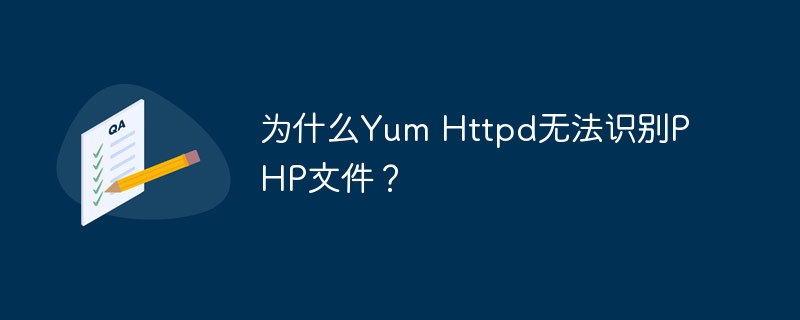Why doesn't Yum Httpd recognize PHP files?

Tools such as Yum, Httpd and PHP are often used when building websites, but sometimes you encounter a problem, that is, the Httpd installed by Yum cannot recognize PHP files. This problem may cause the website to not function properly, so it is important to understand the cause of this problem and how to solve it.
First of all, let’s understand why Yum Httpd cannot recognize PHP files. In the process of building a website, we usually choose to use Apache as the web server, and Httpd is actually a name for Apache. PHP is a server-side scripting language used to develop dynamic web pages. When a web server does not recognize a PHP file, it is usually due to a missing PHP module. Because Httpd does not come with PHP functions, you need to install the PHP module to parse and execute PHP files. If the PHP module is not installed, Httpd will not be able to recognize PHP files and therefore will not be able to execute PHP code correctly.
Now let’s take a look at how to solve the problem that Yum Httpd cannot recognize PHP files through specific code examples. First, we need to make sure that Httpd and PHP are installed. If not installed, you can use Yum to install it:
sudo yum install httpd sudo yum install php php-mysql
After the installation is complete, we need to start Httpd:
sudo systemctl start httpd
Next, we need to edit Httpd The configuration file httpd.conf adds recognition and processing of PHP files. Find the httpd.conf file and open it with an editor. Find the following content in the file:
<IfModule dir_module>
DirectoryIndex index.html
</IfModule>Add the following configuration at this location to tell Httpd to parse the .php file:
<FilesMatch .php$>
SetHandler application/x-httpd-php
</FilesMatch>Save and exit Editor, and then restart the Httpd server:
sudo systemctl restart httpd
In this way, Httpd is configured to recognize PHP files. Next, you can write a simple PHP file to test whether the problem has been solved. Create a new test.php file with the following content:
<?php phpinfo(); ?>
Put the test.php file in the root directory of the website (usually /var/www/html/), and then access the file in the browser. If If you can see the PHP information page, it means that the problem has been solved and Httpd can correctly identify the PHP file and execute the code in it.
In general, the problem that Yum Httpd cannot recognize PHP files is usually caused by the lack of PHP modules. By installing the PHP module and configuring the relevant settings of Httpd, we can easily solve this problem. I hope this article can help readers who encounter similar problems so that they can successfully set up and run their own websites.
The above is the detailed content of Why doesn't Yum Httpd recognize PHP files?. For more information, please follow other related articles on the PHP Chinese website!

Hot AI Tools

Undresser.AI Undress
AI-powered app for creating realistic nude photos

AI Clothes Remover
Online AI tool for removing clothes from photos.

Undress AI Tool
Undress images for free

Clothoff.io
AI clothes remover

AI Hentai Generator
Generate AI Hentai for free.

Hot Article

Hot Tools

Notepad++7.3.1
Easy-to-use and free code editor

SublimeText3 Chinese version
Chinese version, very easy to use

Zend Studio 13.0.1
Powerful PHP integrated development environment

Dreamweaver CS6
Visual web development tools

SublimeText3 Mac version
God-level code editing software (SublimeText3)

Hot Topics
 CakePHP Project Configuration
Sep 10, 2024 pm 05:25 PM
CakePHP Project Configuration
Sep 10, 2024 pm 05:25 PM
In this chapter, we will understand the Environment Variables, General Configuration, Database Configuration and Email Configuration in CakePHP.
 PHP 8.4 Installation and Upgrade guide for Ubuntu and Debian
Dec 24, 2024 pm 04:42 PM
PHP 8.4 Installation and Upgrade guide for Ubuntu and Debian
Dec 24, 2024 pm 04:42 PM
PHP 8.4 brings several new features, security improvements, and performance improvements with healthy amounts of feature deprecations and removals. This guide explains how to install PHP 8.4 or upgrade to PHP 8.4 on Ubuntu, Debian, or their derivati
 CakePHP Date and Time
Sep 10, 2024 pm 05:27 PM
CakePHP Date and Time
Sep 10, 2024 pm 05:27 PM
To work with date and time in cakephp4, we are going to make use of the available FrozenTime class.
 CakePHP File upload
Sep 10, 2024 pm 05:27 PM
CakePHP File upload
Sep 10, 2024 pm 05:27 PM
To work on file upload we are going to use the form helper. Here, is an example for file upload.
 CakePHP Routing
Sep 10, 2024 pm 05:25 PM
CakePHP Routing
Sep 10, 2024 pm 05:25 PM
In this chapter, we are going to learn the following topics related to routing ?
 Discuss CakePHP
Sep 10, 2024 pm 05:28 PM
Discuss CakePHP
Sep 10, 2024 pm 05:28 PM
CakePHP is an open-source framework for PHP. It is intended to make developing, deploying and maintaining applications much easier. CakePHP is based on a MVC-like architecture that is both powerful and easy to grasp. Models, Views, and Controllers gu
 CakePHP Creating Validators
Sep 10, 2024 pm 05:26 PM
CakePHP Creating Validators
Sep 10, 2024 pm 05:26 PM
Validator can be created by adding the following two lines in the controller.
 How To Set Up Visual Studio Code (VS Code) for PHP Development
Dec 20, 2024 am 11:31 AM
How To Set Up Visual Studio Code (VS Code) for PHP Development
Dec 20, 2024 am 11:31 AM
Visual Studio Code, also known as VS Code, is a free source code editor — or integrated development environment (IDE) — available for all major operating systems. With a large collection of extensions for many programming languages, VS Code can be c






